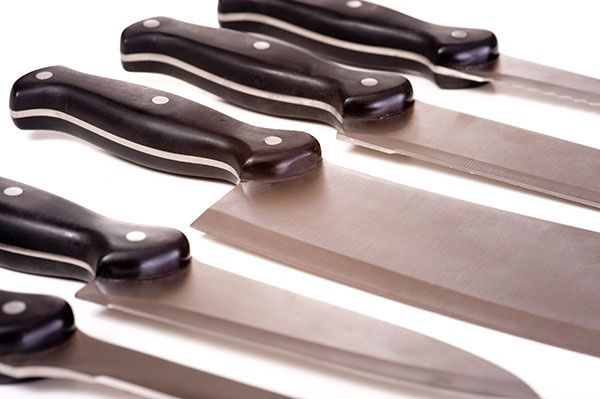
A good knife begins with a single piece of metal that is stamped or forged into a blade of the desired shape then tempered to improve its strength and durability. The primary metals used for knife blades are:
- Carbon steel: An alloy of carbon and iron which is soft enough to be sharpened easily, but tends to corrode and discolor
- Stainless steel: Will not rust, corrode or discolor and is extremely durable, yet it’s more difficult to sharpen than carbon steel, but will hold its edge longer than carbon steel
- High carbon stainless steel: An alloy combining the best features of carbon steel and stainless steel, it resists corrosion and discoloration, and is easily sharpened
- Ceramic: A ceramic called zirconium oxide is used to make knife blades that are extremely sharp, very easy to clean, rustproof and non-reactive. They remain sharp for years, but must be sharpened professionally on special diamond wheels and are not as flexible as metal.
Blades
The portion of the blade that is attached to the handle of the knife is known as the tang. Higher quality knives are constructed with a full tang running the length of the handle. Less expensive knives have ¾ length tang or a thin “rat-tail” tang, which do not provide as much support, durability or balance.
Handles
Knife handles are often made of hard woods infused with plastic, which is riveted to the tang. Molded polypropylene handles are permanently bonded to a tang without seams or rivets. Stainless steel handles welded directly to the blade are durable and very lightweight.
Knife Shapes
- French or Chef’s knife: An all-purpose knife used for peeling, trimming, slicing, chopping and mincing. The blade can range from 8 to 14 inches in length, and from 1½ to 2 inches in width at the handle. The knife tip can be used for trimming, peeling or scoring foods. The blade edge can be used for slicing, chopping and dicing vegetables and meats, and the flat side can be used to crush garlic.
- Utility knife: An all-purpose knife used for cutting fruits and vegetables, or carving poultry with a 6- to 8-inch long blade.
- Boning knife: A smaller knife with a thin blade used to separate meat from the bone with a blade length of 5 to 7 inches. Boning can either be flexible or rigid.
- Paring knife: A short knife used for detail work or cutting fruits and vegetables. The blade is rigid with a length of 2 to 4 inches.
- Cleaver: A knife with a large, heavy rectangular blade used for chopping or cutting through bones.
- Slicer: A knife with a long, thin blade used primarily for slicing cooked meat. The tip may be round or pointed while the blade may be flexible or rigid. A similar version of a slicer with a serrated edge is used for slicing bread or pastries.
- Oyster and clam knives: The short rigid blades of these knives are used to open oyster and clam shells. The tips are blunt, and only the clam knife has a sharp edge.
- Steel: A scored, slightly abrasive steel rod used to hone, or straighten, a blade.
- Sharpening stone: Also known as a whetstone, a sharpening stone is a flat brick of synthetic abrasives used to sharpen a dull blade.





